Pressure, Winds, Storms, and Cyclones NCERT Solutions | Science Curiosity Class 8 - New NCERT PDF Download
Probe and ponder
1. Why are winds stronger on some days than on others?
Ans:
- Winds are stronger on some days due to greater differences in air pressure (pressure gradients) between different locations.
- When a weather system, such as a storm or a cyclone, creates steep pressure differences, air moves rapidly from high-pressure areas to low-pressure areas, resulting in strong winds.
- Temperature contrasts (such as between land and sea, or during weather fronts), and local topography can intensify these differences and wind speeds.
2. Why are water tanks usually placed at a height?
Ans:
- Water tanks are elevated to use gravity to increase water pressure for distribution.
- Height ensures that water flows with enough pressure through pipes to reach all taps—even those on upper floors—without requiring electric pumps.
- The formula P=hρg shows water pressure depends on the height (h) above the outlet.
3. Can air pressure really crush us?
Ans:
- Atmospheric pressure is indeed very strong (about 101,325 Pa at sea level, or approximately 10 tons on your body surface!).
- However, the pressure inside our bodies matches the outside pressure, balancing the force.
- Without this balance (for example, if strong pressure differentials appear suddenly), air pressure can cause serious damage—as seen when containers or objects are evacuated of air and crushed by outside air.
4. What causes storms and cyclones? If the Earth stopped rotating, would cyclones still form?
Ans:
- Storms and cyclones are caused by warm, moist air rising rapidly. As this air cools, water vapor condenses, releasing heat and causing strong winds and clouds. Cyclones specifically form over warm oceans, with rotation guided by Earth’s spin (the Coriolis effect).
- If the Earth stopped rotating, cyclones as we know them wouldn't form. The rotation (Coriolis force) is what makes winds spiral, creating the cyclonic structure. Without it, storms could still occur, but organized, rotating cyclones would not.
5. Share your questions
Ans: Possible questions you might ask after exploring these ideas:
Why don't we feel atmospheric pressure even though it is so high?
How do buildings and bridges withstand strong winds during storms?
Do animals sense changes in air pressure before storms?
What scientific instruments are used to measure wind speed and pressure?
How do disaster warning systems work for cyclones?
Keep the curiosity alive
1. Choose the correct statement.
(i) Look at Fig. 6.21 carefully. Vessel R is filled with water. When pouring of water is stopped, the level of water will be ____________________. 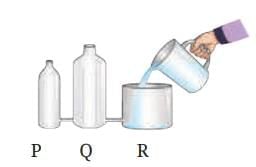 (a) the highest in vessel P
(a) the highest in vessel P
(b) the highest in vessel Q
(c) the highest in vessel R
(d) equal in all three vessels
Ans: (d) equal in all three vessels
The level of water in connected vessels (communicating vessels) will be the same regardless of shape, as liquid pressure depends on the height of the column, not the vessel's shape or width
(ii) A rubber sucker (M) is pressed on a flat smooth surface and an identical sucker (N) is pressed on a rough surface:
(a) Both M and N will stick to their surfaces.
(b) Both M and N will not stick to their surfaces.
(c) M will stick but N will not stick.
(d) M will not stick but N will stick.
Ans: (c) M will stick but N will not stick
The rubber sucker sticks due to atmospheric pressure creating a vacuum on a smooth surface. On a rough surface, air leaks in, preventing the vacuum and thus the sticking.
(iii) A water tank is placed on the roof of a building at a height ‘H’. To get water with more pressure on the ground floor, one has to
(a) increase the height ‘H’ at which the tank is placed.
(b) decrease the height ‘H’ at which the tank is placed.
(c) replace the tank with another tank of the same height that can hold more water.
(d) replace the tank with another tank of the same height that can hold less water.
Ans: (a) increase the height ‘H’ at which the tank is placed
Liquid pressure increases with the height of the water column. Raising the tank increases the pressure, resulting in a stronger stream of water.
(iv) Two vessels, A and B contain water up to the same level as shown in Fig. 6.22. PA and PB is the pressure at the bottom of the vessels. FA and FB is the force exerted by the water at the bottom of the vessels A and B. 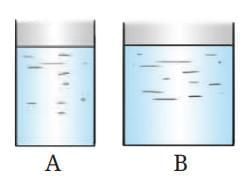
(a) PA = PB, FA = FB
(b) PA = PB, FA < FB
(c) PA < PB, FA = FB
(d) PA > PB, FA > FB
Ans: Pressure at the bottom depends on the height of the water, which is the same in both vessels, so PA = PB. Force equals pressure times area; since vessel A is narrower (smaller area), FA < FB.
2. State whether the following statements are True [T] or False [F].
(i) Air flows from a region of higher pressure to a region of lower pressure. [ ]
(ii) Liquids exert pressure only at the bottom of a container. [ ]
(iii) Weather is stormy at the eye of a cyclone. [ ]
(iv) During a thunderstorm, it is safer to be in a car. [ ]
Ans: (i) True [T] – Air flows from a region of higher pressure to a region of lower pressure.
(ii) False [F] – Liquids exert pressure on the bottom, sides, and in all directions within a container.
(iii) False [F] – The eye of a cyclone is calm, with no stormy weather.
(iv) True [T] – During a thunderstorm, it is safer to be in a car, as it acts as a protective enclosure (like a Faraday cage) against lightning.
3. Fig. 6.23 a shows a boy lying horizontally, and Fig. 6.23b shows the boy standing vertically on a loose sand bed. In which case does the boy sink more in sand? Give reasons.
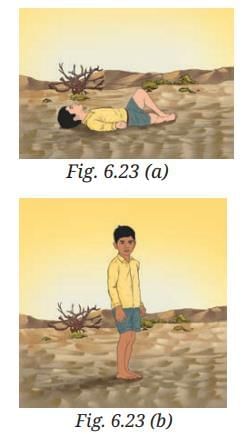
Ans:
- The boy will sink more when standing vertically (Fig. 6.23 b). When standing, his weight acts on a smaller area (his feet), resulting in higher pressure that causes more sinking.
- When lying horizontally (Fig. 6.23 a), his weight is distributed over a larger area, reducing the pressure and minimizing sinking.
4. An elephant stands on four feet. If the area covered by one foot is 0.25 m2 , calculate the pressure exerted by the elephant on the ground if its weight is 20000 N.
Ans:
- Total area covered by four feet = 4 × 0.25 m² = 1 m².
- Pressure = Force / Area = 20000 N / 1 m² = 20000 N/m² (or 20000 Pa).
5. There are two boats, A and B. Boat A has a base area of 7 m2 , and 5 persons are seated in it. Boat B has a base area of 3.5 m2 , and 3 persons are seating in it. If each person has a weight of 700 N, find out which boat will experience more pressure on its base and by how much?
Ans: Weight per person = 700 N.
Boat A: Total weight = 5 × 700 N = 3500 N; Pressure = 3500 N / 7 m² = 500 Pa.
Boat B: Total weight = 3 × 700 N = 2100 N; Pressure = 2100 N / 3.5 m² = 600 Pa.
Boat B experiences more pressure on its base, by 100 Pa.
6. Would lightning occur if air and clouds were good conductors of electricity? Give reasons for your answer.
Ans:
- No, lightning would not occur. Lightning results from the buildup and sudden discharge of static charges in clouds, which requires air to act as an insulator.
- If air and clouds were good conductors, charges would flow continuously without building up enough to cause a discharge.
7. What will happen to the two identical balloons A and B as shown in Fig. 6.24 when water is filled into the bottle up to a certain height. Will both the balloons bulge? If yes, will they bulge equally? Explain your answer.
Ans:
- Both balloons will bulge, and they will bulge equally.
- The pressure exerted by the water depends on the height of the water column in the bottle, not the diameter of the connections or balloons.
- Since the water is filled to the same height, the pressure is the same, causing equal bulging.
8. Explain how a storm becomes a cyclone.
Ans:
- A storm becomes a cyclone over warm ocean waters. Warm, moist air rises, creating a low-pressure area.
- Surrounding cooler air rushes in, warms, and rises, while water vapor condenses, releasing heat that fuels further rising.
- Earth's rotation causes the air to spin, forming a rotating system of clouds, high-speed winds, and rain around a low-pressure center (the eye).
- This intensifies into a cyclone as the process repeats.
9. Fig. 6.25 shows trees along the sea coast in a summer afternoon. Identify which side is land— A or B. Explain your answer.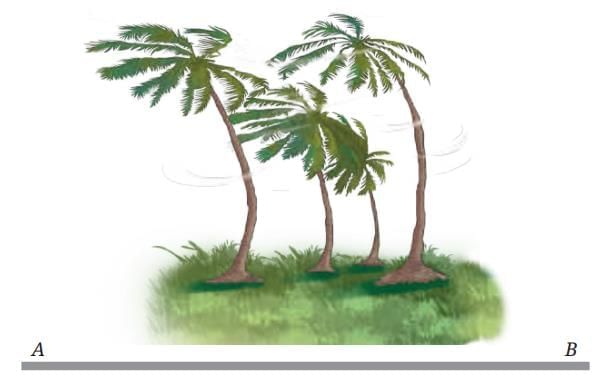
Ans: Side B is land. In a summer afternoon, land heats faster than the sea, creating low pressure over land. This causes a sea breeze to blow from the sea (side A) toward the land (side B), bending the trees toward side B.
10. Describe an activity to show that air flows from a region of high pressure to a region of low pressure.
Ans:
- Take two similar balloons and a straw. Insert one end of the straw into an uninflated balloon and secure it.
- Inflate the second balloon, secure its mouth, then insert the other end of the straw into it without leaking air.
- Air flows from the inflated (high-pressure) balloon to the uninflated (low-pressure) one through the straw, causing the inflated balloon to shrink and the other to expand until pressures equalize.
11. What is a thunderstorm? Explain the process of its formation.
Ans:
- A thunderstorm is a storm accompanied by lightning, thunder, and often heavy rain.
- It forms when warm, moist air rises rapidly, cools, and condenses into clouds.
- Strong upward and downward winds cause ice particles and water droplets to rub, building static charges (positive at the top, negative at the bottom).
- When charges build sufficiently, air's insulating property breaks, leading to lightning discharges and thunder.
12. Explain the process that causes lightning.
Ans:
- Lightning occurs due to charge separation in clouds during a thunderstorm.
- Strong winds cause ice particles (positively charged) to rise to the cloud's top and water droplets (negatively charged) to stay at the bottom. This separation builds up opposite charges.
- When the buildup is large enough, air's insulation breaks, allowing a sudden flow of charges, producing a bright flash (lightning) within a cloud, between clouds, or to the ground.
13. Explain why holes are made in banners and hoardings.
Ans: Holes allow high-speed winds to pass through, reducing the pressure difference between the front and back. Without holes, wind pressure could tear or blow away the banners, especially during storms.
Discover, design, and debate
1. Hold a strip of paper, 18 cm long and 2 cm wide, between your thumb and forefinger so that it hangs freely. Predict what you will observe if you blow over the paper. Perform the activity now. Note down your observations and interpret your results.
Ans:
Prediction:
When you hold a strip of paper by your thumb and forefinger so it hangs freely, and blow air over the top surface of the strip, you might expect the paper to move down due to the force of the air. However, the actual observation defies this intuition.
Observation:
When you blow forcefully over the top of the paper, the strip of paper rises up instead of moving down.
Interpretation:
This occurs due to pressure difference explained by Bernoulli’s principle. Blowing air over the top increases the speed of air above compared to the still air below, resulting in lower pressure on top and higher pressure underneath. The higher pressure below pushes the paper upwards. This is the same principle that helps airplanes fly.
2. List three major cyclones which have occured in India in the last 20 years. List two major destruction caused by each of the cyclones. What measures were taken by the local government and communities to reduce the loss of life and destruction of property? Mention two suggestions you would like to propose to the local government.
Ans: Three Major Cyclones in India in the Last 20 Years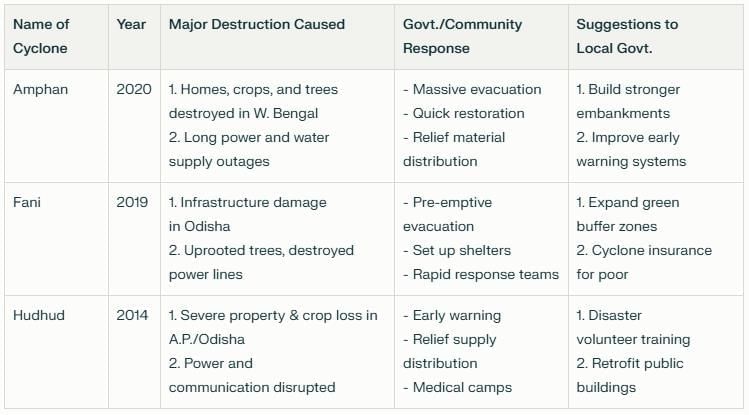 For all major cyclones, the Indian government has developed:
For all major cyclones, the Indian government has developed:
The National Cyclone Risk Mitigation Project (NCRMP) to build cyclone shelters, strengthen infrastructure, and promote early warning dissemination.
Community-based disaster management, where local volunteers are trained to assist in evacuations and first response.
3. Collect data on the strength of thunderstorms for various regions of India. Compare your findings and identify which regions are more prone to thunderstorms. Can you give reasons for your findings?
Ans:
Regional Data:
North-East India: Highest thunderstorm frequency, with some locations experiencing over 100 thunderstorm days per year (especially Assam, Meghalaya, Sub-Himalayan West Bengal).
East India (Odisha, West Bengal, Jharkhand, Chhattisgarh, Bihar): 30–50 thunderstorm days/year; high intensity.
Southern Peninsula (including Karnataka, Tamil Nadu): 60–80 thunderstorm days/year in some parts, with Bengaluru region averaging ~41 thunderstorm days and ~157 lightning events annually.
Central/Western India: Lesser frequency but still significant, particularly during pre-monsoon.
Reasons for Regional Variation:
North-East and eastern India: Thunderstorms, locally called “Nor’westers” (Kalboishakhi), are frequent in the pre-monsoon months due to high moisture, temperature, and terrain effects.
Southern India: The convergence of Southwest and Northeast monsoon winds, abundant moisture, and heat creates ideal conditions for frequent and intense thunderstorms, especially post-monsoon.
Coastal and foothill regions: Interaction between land and sea, rapid heating, and orographic uplift strengthen thunderstorm activity.
Thunderstorm Strength in Various Regions of India:
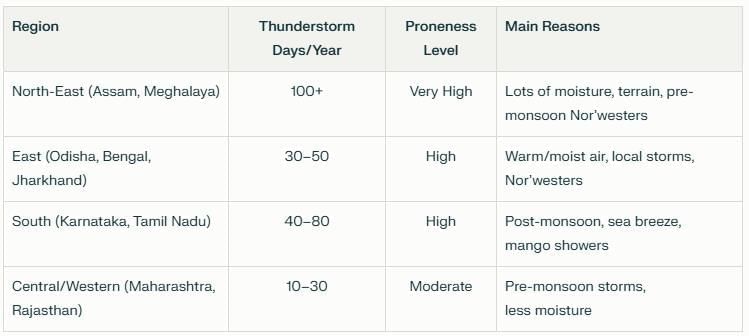
|
54 videos|234 docs|13 tests
|
FAQs on Pressure, Winds, Storms, and Cyclones NCERT Solutions - Science Curiosity Class 8 - New NCERT
| 1. What is pressure and how is it measured? |  |
| 2. How do winds form and what factors affect their direction? |  |
| 3. What are the characteristics of a cyclone? |  |
| 4. What safety measures should be taken during a storm or cyclone? |  |
| 5. What is the difference between a storm and a cyclone? |  |
















